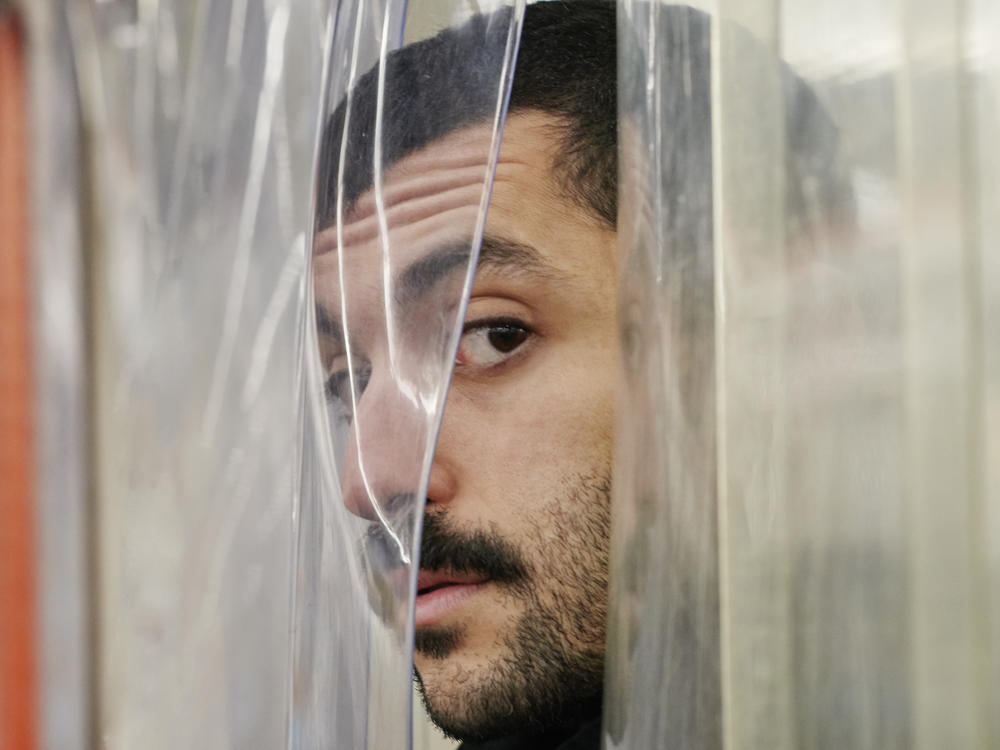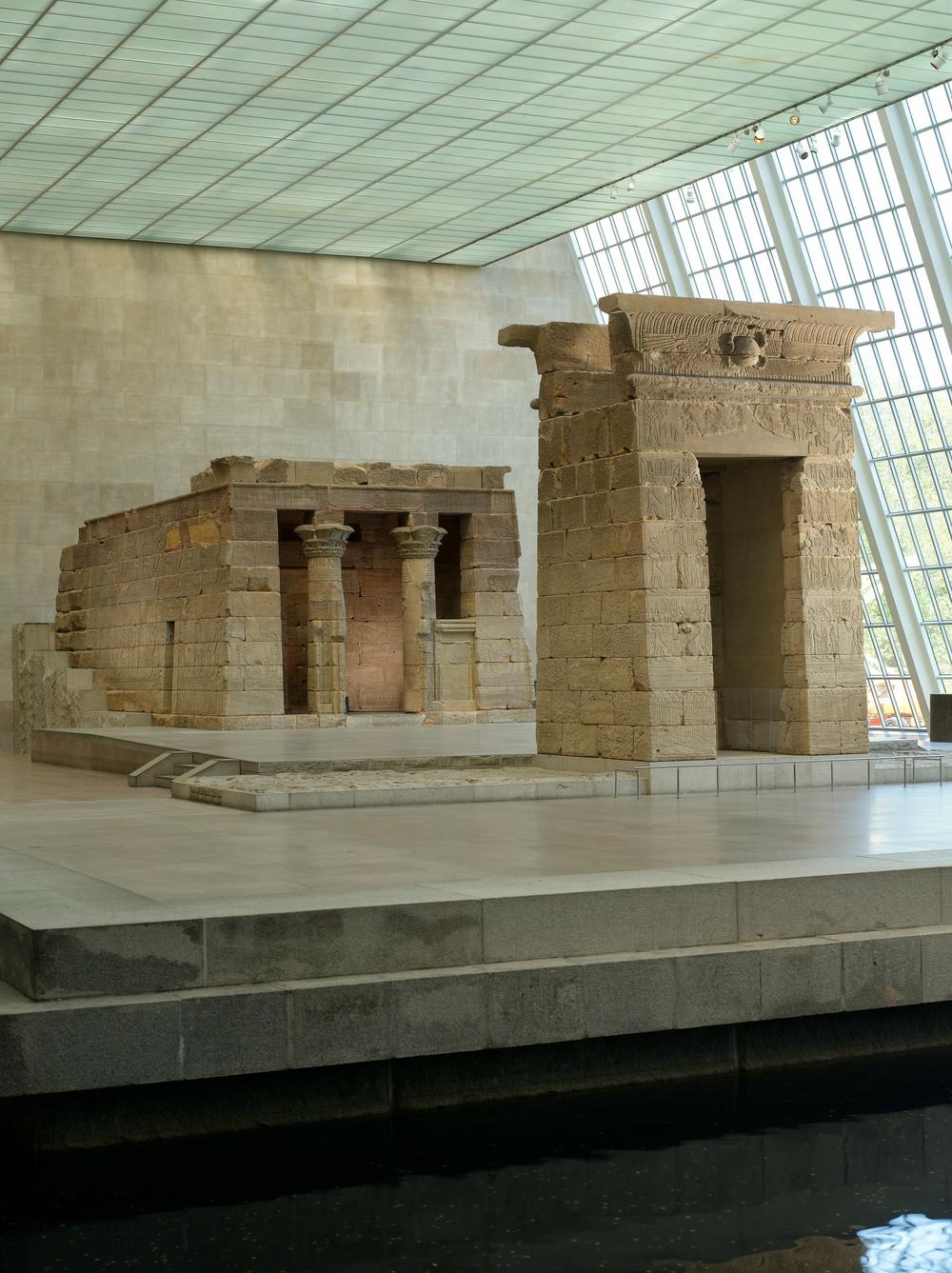Section Branding
Header Content
An ancient Egyptian temple in New York inspires a Lebanese American musician
Primary Content
For nearly 50 years, the Temple of Dendur, an ancient Egyptian monument, has famously made its home at New York City's Metropolitan Museum of Art. The temple is also an inspiration for musicians and dancers who have been invited to perform there. The latest is singer and composer H. Sinno, born and raised in Lebanon. Their opera Westerly Breath had its world premiere at the temple on Friday.
H. Sinno, also known as Hamed Sinno, used to be the lead singer for a groundbreaking indie rock band in Beirut called Mashrou' Leila. Sinno was an out gay person, and the band championed LGBTQ rights and equality in the Middle East and North Africa, within an often hostile climate.
The band became very popular throughout the region — but its members also faced death threats, and they were widely banned from performing. But a culminating blow, Sinno says, was when an Egyptian fan, Sarah Hegazy, was imprisoned in 2017 for waving a rainbow flag at one of their shows. As Hegazy told NPR in 2018, she was assaulted in prison and suffered PTSD. Three years later, Hegazy died by suicide in Canada, where she had been granted asylum.
Her struggle catalyzed Sinno's move to the U.S. (He already held dual U.S. citizenship with Lebanon.)
"For quite a long time, when I was working with Mashrou' Leila and when my primary audience was in the Arab world, it felt like there was a very clear sense of purpose — that was my job and what I wanted to do for myself as well," Sinno says. "It aligned with what I wanted for the world around me in terms of change. And obviously, we got punished for that repeatedly, got banned from everywhere."
"Just this question arose of what is the point of what I'm doing, especially after the death of Sarah Hegazy," Sinno says, "which really just made it so that nothing that I have written since has not just had her face branded on my brain while writing."
Sinno delved deep into the nuanced history of the temple while developing Westerly Breath.
"Unlike many relics that you see in American and European museums, this was not stolen," Sinno observes. Instead, the Roman-era temple was given to the United States by the Egyptian government during the rule of former Egyptian president Gamal Abdel Nasser in the 1960s. Its existence, and that of several other ancient structures, had been threatened by the building of the Aswan Dam. The U.S. donated $16 million to preserve the ancient monuments, and Nasser gave the U.S. this temple in gratitude. It was dismantled, moved in 661 blocks, and reconstructed in New York.
Still, Sinno maintains, the temple has a complex story: Nasser was a leader and hero of the pan-Arabism movement. "The building of the Aswan Dam, in the history of the Arab world and in the history of Arab nationalism, is such a sort of monument to pan-Arabism, to Arab nationalism, to decolonial struggle, but was actually a very problematic project," Sinno asserts. (The construction of the dam submerged the region of Nubia and displaced tens of thousands of indigenous Nubians. Additionally, Nasser drove several minority communities out of Egypt during this period, including this reporter's family.) "So I had the idea that this temple sort of had to flee Arab nationalism."
Sinno, who uses they/them pronouns, says the temple became a ripe metaphor for their move to the U.S.
"For this temple to come to the U.S. in pieces and be rebuilt at the Met," Sinno says, "felt to me very much like how I experienced immigration too, of just feeling like I needed to leave. The timing of my emigration was also remarkable. You couldn't plan it in a worse way. I came here in 2019 — right before the banking crisis in Lebanon, right before the failed Lebanese revolution, right before COVID, before George Floyd. I did, at some point, feel like I was just as in pieces. And so the opera is stories about things or people that are taken apart and then have to be rebuilt and sort of become something else."
Westerly Breath — a piece for voices, strings and electronics — is less about answers than a snapshot of Sinno's process of self-questioning and self-reimagining.
One of several threads running through the work is ancient Egyptian myth and the story of the god Osiris, who was believed to be the first mummy. He was killed by his brother, Seth.
"Seth ultimately rips his brother up into a bajillion pieces," Sinno explains, "spreads them all over Egypt, and then his sister-slash lover, Isis, recollects those pieces, puts them back together, and creates the first mummy — through that, he is reanimated as something else. There's a sort of crossing over through dismemberment and then remember-ment, which I like to think of as a remembrance as well."
H. Sinno says that there's also something about the temple itself — its sheer size and heft — that can hold all the layers of stories they want to tell.
"It has that sort of insane gravitas about it," Sinno says of the temple. "Even sonically, you're just constantly confronted with how small you are. What that does to the voice is really quite magical: you say something, and then you hear the reflection. And you're just confronted with time — you've already moved on, and that voice comes back at you from another time. It's really very, very magical."
Limor Tomer heads the Department of Live Arts at the Met. She points out that the Sinno's old band, Mashrou' Leila, met while studying architecture in Beirut — and that background drew her in.
"They come from architecture and visual art, which is very helpful when you invite an artist to create a performance in a gallery," Tomer observes. "They bring a different kind of sensibility and awareness of objects and architecture. And it seemed to me like the way that H. thinks about objects and their interaction with sound and movement would make for an interesting piece."
H. Sinno says they hope this opera can also travel to other locations for performances— because the opera carries within it the story of the temple of Dendur itself.
If you or someone you know may be considering suicide or be in crisis, call or text 988 to reach the Suicide & Crisis Lifeline.
Copyright 2024 NPR. To see more, visit https://www.npr.org.


